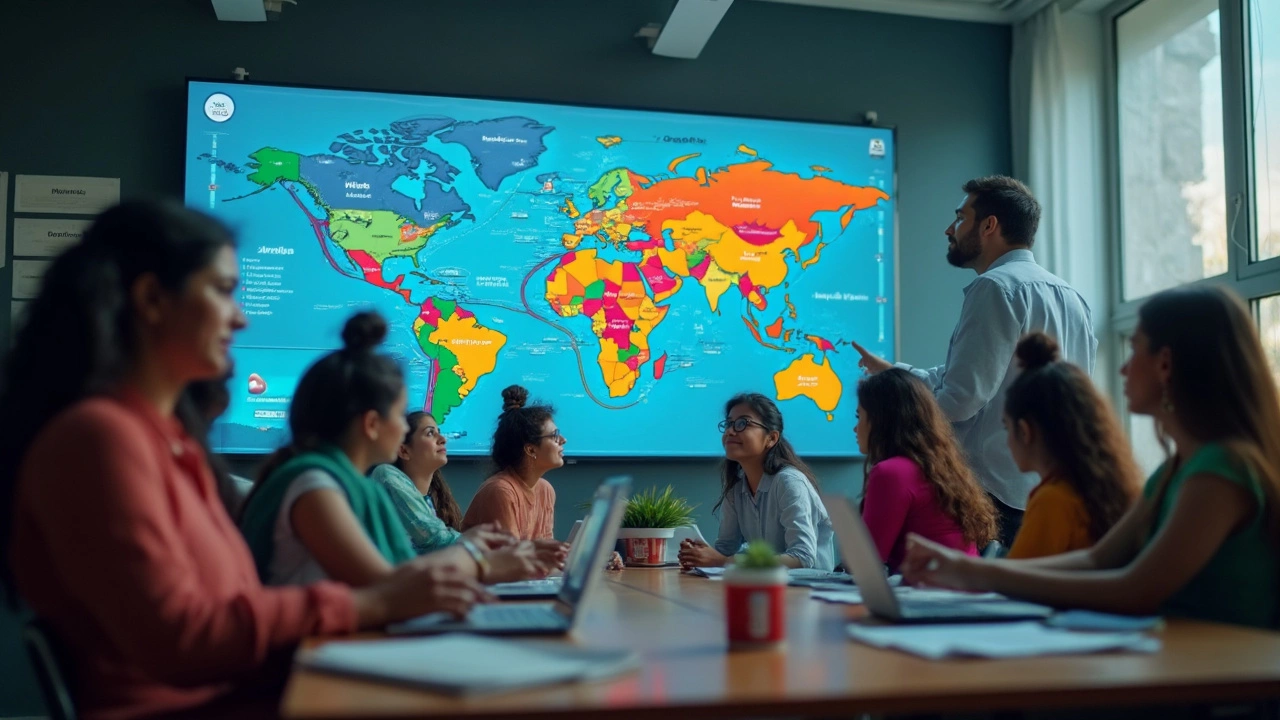Ever wondered what kind of trade really drives India’s economy? There’s no mystery here—India’s trade is a mix of classics like spices and textiles, and modern stuff like engineering goods and IT services. Whether you see yourself dealing with raw cotton or the latest gizmos, it’s all part of the same trade universe.
Here’s the straight truth: India trades both inside the country (domestic) and across borders (international). Exports mean sending goods and services out, bringing in much-needed money, while imports fill gaps in resources and tech. Want to get into the action? It pays to know what sells, what’s in demand, and how the process works—especially if you’re eyeing a trade course or a job in the sector.
- India’s Main Trade Types
- Key Import and Export Sectors
- How Domestic and International Trade Work
- Skills Needed in India’s Trade Sector
- Tips for Choosing the Right Trade Course
India’s Main Trade Types
When people talk about trade in India, they usually mean two big categories: domestic trade and international trade. Domestic trade is all about buying and selling within India’s borders. This includes everything from local farmers supplying vegetables to cities, to big companies selling smartphones across different states.
International trade, on the other hand, is India dealing with other countries—sending goods and services out (exports), and bringing stuff in (imports). In fact, India traded with over 200 countries in 2024 alone.
Now, let’s break these down further:
- Internal (Domestic) Trade: This is the backbone of daily business in India. It runs through wholesale markets, retail shops, and now, even online marketplaces. Goods often move across state borders, thanks to a unified tax system called GST.
- External (International) Trade: This is where India trade and import export skills shine. India exports things like petroleum products, minerals, jewelry, textiles, and IT services. On the flip side, the country imports crude oil, electronics, gold, and machinery. Each year, the balance between exports and imports (called the trade balance) is a big deal for the economy.
What about the way these trades happen? There’s visible trade (physical goods you can touch, like cars and rice) and invisible trade (services—think software development, call centers, consulting).
Just to give you an idea, check out India’s total trade numbers for 2023–24:
| Type | Exports (USD Billion) | Imports (USD Billion) |
|---|---|---|
| Merchandise (Goods) | 435 | 675 |
| Services | 340 | 220 |
That’s a lot of business—over $1.6 trillion combining goods and services. Whether you want to trade at the local market or dream of working with global clients, knowing how these trade types work is your first building block. It’s what most trade courses in India start with, too.
Key Import and Export Sectors
When you think about India trade, you’re looking at a wild mix of both tradition and innovation. India is still global-famous for exporting things like spices, rice, and textiles. But did you know it's also one of the top players in exporting software services and engineering goods? The trade market is wider than most people imagine.
Let’s break things down. On the export side, India’s top earners are:
- Engineering goods: Think machines, cars, and industrial parts. These make up more than 25% of India’s total exports.
- Petroleum products: Refined petroleum is in big demand, especially in Asian and African markets.
- Gems and jewellery: India processes and exports loads of diamonds and gold jewellery, mostly to the US and UAE.
- Pharmaceuticals: India is known as 'the pharmacy of the world,' exporting affordable drugs to over 200 countries.
- IT services and software: A huge chunk of India’s earnings now come from software, IT consulting, and business services, especially to the US and Europe.
On the other hand, here’s where India spends money importing goods:
- Crude oil: India imports more than 80% of its oil needs. This keeps the country moving, literally.
- Electronics: Smartphones, laptops, semiconductors—most of it comes from China and a few other Asian countries.
- Gold: Indians love gold, not just for investment, but also for weddings and festivals. Most of it gets imported.
- Fertilizers and chemicals: With the farming sector still massive in India, the demand for these imports stays high.
- Edible oils: A lot of cooking oils, like palm oil, come from Malaysia and Indonesia.
See how broad the trade map is? Here’s a quick look at recent data if you’re curious about the numbers:
| Sector | Exports (USD Billion, 2023) | Imports (USD Billion, 2023) |
|---|---|---|
| Engineering Goods | 107 | 45 |
| Petroleum Products | 94 | 160 |
| Gems & Jewellery | 40 | 35 |
| Pharmaceuticals | 28 | 7 |
| Electronics | 16 | 70 |
So, if you’re considering trade courses in India, understanding these sectors will give you an idea about where the action really is. The biggest opportunities often follow where there’s the most movement—on both export and import sides.

How Domestic and International Trade Work
If you want to really understand the India trade scene, it’s best to start with the difference between domestic and international trade. Domestic trade means transactions that happen within India's borders—state to state, city to city. International trade, on the other hand, is all about selling to or buying from other countries. Both types play a huge role in the Indian economy, and each comes with its own set of rules, systems, and challenges.
Domestic trade is usually simpler. Goods made in Maharashtra can be sent to Delhi, or rice grown in Tamil Nadu may show up on shelves in Haryana. No customs paperwork, no conversion of currencies; just goods moving around with taxes like GST applied. Most small businesses start here before jumping into bigger markets.
International trade gets a bit more complex. You deal with different currencies, strict regulations, customs paperwork, and global competition. The government keeps a close watch—there are export-import policies, licenses, duties, and quality checks. For example, electronic gadgets exported from India need to meet both Indian and the destination country’s safety standards. Likewise, raw oil imported from the Middle East is tracked and taxed.
Here’s a quick breakdown:
- Domestic trade: Faster, less paperwork, usually done by smaller companies and traders, and driven by demand across states.
- International trade: More opportunity for big profits, but more risk and complexity. Useful for those who have mastered local markets and want to expand.
Just to put things in perspective, check out these recent stats from 2024:
| Type of Trade | Indian Trade Value (Billion USD) | Main Products |
|---|---|---|
| Domestic | Over 1,800 | Textiles, FMCG, agriculture |
| International - Export | 437 | Petroleum, gems, software, pharmaceuticals |
| International - Import | 677 | Crude oil, electronics, gold, chemicals |
So if you’re going for a trade course, try to figure out which side interests you more. Domestic trade is a great training ground, while international trade gets you into the global spotlight—the choice depends on your ambition and appetite for risk.
Skills Needed in India’s Trade Sector
If you want to break into India trade, you can’t just wing it. Even if you’re good at bargaining at your local market, trading at scale means picking up real skills that matter. Companies aren’t only looking at degrees—they want people who actually know how the system works and can roll with the ups and downs of global business.
Let’s get practical about what you’ll actually use:
- Communication and Negotiation: You’ll deal with suppliers, buyers, and customs officials. Clear emails, confident calls, and knowing how to strike a fair deal make a real difference.
- Knowledge of Regulations: Import-export laws, GST, tariffs—these change often. Staying up-to-date keeps you out of trouble and ahead of your competition.
- Handling Documentation: Messy paperwork can sink a deal. You need to get shipping bills, invoices, and custom forms right every time.
- Understanding Global Markets: What’s selling in the UAE, Europe, or the US? Tracking trends and knowing which goods and services are hot will push you ahead.
- Digital Skills: Most trade work now goes digital. You’ll want basic spreadsheet skills, knowledge of e-filing, and a handle on tracking software. A lot of exporters in India use the DGFT portal for paperwork, so getting familiar helps.
- Problem-Solving: Sometimes shipments get stuck or loose in transit. You need to think quick and fix issues without panicking.
According to a 2023 survey by the Federation of Indian Export Organisations (FIEO), 85% of successful traders listed negotiation and compliance as must-have skills, even outranking product knowledge in some cases. Here’s a quick look at what trade skills Indian employers value most:
| Skill | Percentage of Employers |
|---|---|
| Negotiation & Communication | 85% |
| Documentation Know-how | 81% |
| Regulatory Awareness | 78% |
| Digital Competence | 69% |
| Foreign Language | 24% |
“If you don’t stay updated on changing trade policies and digital tools, you’ll struggle to close deals. Adaptability and know-how count more than theory in today’s India trade market.” — Rajesh Bhatia, Export Consultant, FIEO
So, if you plan on taking up any trade courses, make sure they go beyond textbook stuff. Look for hands-on lessons about paperwork, digital tools, and live case studies. Real skills make you employable fast, not just the certificate.

Tips for Choosing the Right Trade Course
Picking a trade course can get overwhelming—there are dozens out there, and not all of them match today’s job trends or your interests. The first thing to ask yourself: What do you want from the trade—big companies, global trade, government work, or running your own shop? Each path can need different skills and focus areas.
If you want to work on the international side (exports/imports), look for courses that offer hands-on training in documentation, shipping, and compliance with Indian and global trade rules. The Federation of Indian Export Organisations (FIEO) and the Indian Institute of Foreign Trade (IIFT) are reliable places to check out. As per IIFT’s recent stats, their job placement rate for international trade roles is about 80% after graduation, which says a lot about the value of practical learning.
Here’s a simple checklist to help you decide on the right course:
- Make sure the institute is recognized by a government body or a respected industry group.
- Does it offer internships or live projects? That stuff matters way more than just classroom theory.
- Check if the curriculum covers updates in India trade, including e-commerce, logistics, and digital payments.
- Talk to people working in the sector—find out which courses gave them a real advantage.
- Look up recent reviews and alumni success stories, not just flashy ads.
For those more interested in trading sectors within India, focus on what’s growing fast—think agri-business, renewable energy, or even gems and jewelry. Many government skill centers run special trade courses focused on these areas, and they often cost less than private programs.
"Practical exposure is the top thing employers want in trade roles—don’t settle for basic lectures," says Vivek Sharma, a trade recruiter for multiple export firms in Mumbai.
Costs matter too. Some popular short-term trade courses range from ₹15,000 to ₹60,000, depending on reputation and location. Here’s a quick look:
| Course Provider | Course Fee (Approx.) | Duration |
|---|---|---|
| IIFT | ₹45,000 | 4 months |
| FIEO | ₹20,000 | 2 months |
| Government Skill Center | ₹7,000 | 3 months |
Don’t ignore online options either—platforms like Coursera and UpGrad have India-specific import-export programs taught by pros. Bottom line: Match the course content with where you want to work in the India trade world, and make sure there’s a practical edge. Get these basics right, and you save time and money.



